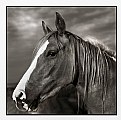diafine is an interesting mix. you mix it up and store it carefully and it seems to last forever.
so far as making it a standard developer, i am not sure it is the best choice. the way it works tends to flatten contrast a bit and the edges seem to be a bit soft. while it is a very good developer for pushing film, for regular daylight photography you may find underrating the film a bit and using a higher accutance developer like D76 might be a better everyday choice. i personally like ilfosol-S becasue as a liquid it is easy to mix and it is available at a low cost in small quantities so i don't feel bad if a bottle sits around too long and has to be disposed of. if i want moderate speed, and fine grain, paterson fx-50 is startign to look good to me, and i appreciate the reduced toxicity. the thing that drives me bats is that i have to order it from out of state because no one seems willing to stock it here.
with hp-5 if you want to process it in diafine, you better shoot it a little higher than 400. 800 works better for me and my condenser enlarger. since diafine *always* develops to completion, it overdevelops film exposed at its normal ISO rating. the usual problems of pushing film creating higher contrast and bigger grain seem to not be an issue with diafine. the real speed king in diafine is kodak tri-x. normally a 400 speed film and most people underrate it a bit, i can get printable negs shot at anything between 1000 and 1600. most other films you just double the stated iso and you will be pretty close. you need to decide if you are going to use diafine before you shootof course because the exposure you use with it will not work with other developers unless you really cook the negs and accept some quality loss.
the stock solution is used straight. i buy the quart sized packages and it makes one quart of solution A and one quart of solution B. you absolutely have to start with dry film. if you pre-soak your film diafine will underdevelop it in very unpredictable ways. at room temperature, fill the tank with part A, let it sit for 3 to 5 minutes. i add the pre-measured amount to my tank, and then agitate it continuously for about 30 seconds, then thump it on the table to dislodge air bubbles. then i just do a couple of inversions every minute thereafter. agitation does have an effect on how it works and that will vary by film emulsion, so be consistent. i then pour that developer back into the bottle and let the tank drain well. it is very important to not contaminate this part A solution with water or other darkroom chemicals. then add part B to the tank and same drill agitate for 30 seconds, then a couple inversions a minute for at least 3 minutes at room temperature. you can then pour this back into your part B bottle.
i do a water stop, then fill the tank and let it stand in clean water for a minute, dump that and then another minute soak in clena water. then i use my fixer like with any other film and follow that with a rinse, then permawash or HCA, then the "ilford wash" using just a couple tanks of clean water with a lot of agitation to save water. dunk in a bucket of photo-flo and hang to dry.
i have had diafine that lasted until my original quart of solution A was about half its original volume. this took about a year and that was probably 50 rolls of film. what was left of the A solution was pretty dark from all the anti-halation dyes in it. i usually replace it sooner than that though. the big tank i use now does not drain very well so i lose solution volume faster. the smallest tank possible with steel reels will reduce the waste.
diafine is something i think everyone should try at least once. but the key is that you control your negative density with the exposure alone, the development is always the same and letting it soak longer has almost no effect. it is possible to re-develop film to get a bigger push out of it, but this takes time and careful washing otherwise it's too easy to contaminate the part A solution. just the residue of part B in the tank can ruin a batch of diafine if it gets mixed back into your stock of part A.
|
















